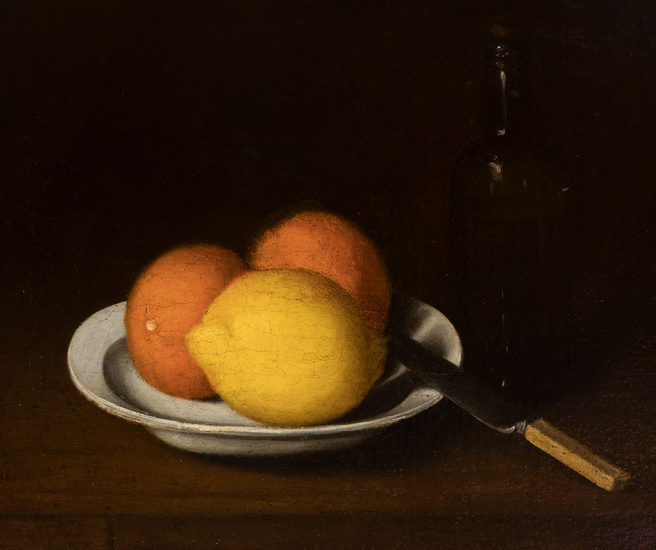Attributed to Juan de Zurbarán
Attributed to JUAN DE ZURBARÁN ( Llerena, Badajoz, 1620- 1649).
"Still life.
Oil on canvas. Relined.
It conserves frame of epoch.
Measurements: 35 x 42.5 cm; 46 x 54.5 cm (frame).
Aesthetically the work presents great features of naturalistic style, firmly rooted in the Spanish tradition of the still life genre. The tenebrist lighting with a spotlight artificially directed towards the lemon and the oranges in the center. The economy both in the elements that make up the scene, as in the rigor of a classic composition bring us closer to a scene where quality is evident and protagonist. The illuminated edge of the knife and the shadow it casts on the white earthenware, the skin of the fruit are details that reveal the quality of the work and the delicacy of the artist.
The work is stylistically close to pieces by the Son of Francisco Zurbarán, such as the "Still Life of Lemons" which belongs to the collection of the Museo de Bellas Artes de San Fernando. Francisco Zurbarán joined the workshop that his father owned in Seville, with whom it is likely that they collaborated on several paintings, including Still Life with Flowerpots. Although it is known that he made several works of religious themes, it was the genre of still life where he was most successful. The paternal influence is evident in his work, but his style also reflects influences Juan van der Hamen, thus differentiating it from the painting of his father. He painted mainly still lifes. Some of his works are Still Life with Fruit and Goldfinch and Still Life with a Basket of Apples, Quinces and Pomegranates, kept in the Museu Nacional d'Art de Catalunya, the Flowers and Fruit in Chinese Porcelain in the Art Institute of Chicago, and the Dish with Apples and Orange Blossoms in a private collection, among other autographed or attributed works. Juan de Zurbarán's career was cut short by his early death at the age of 29. He contracted the plague during the epidemic that devastated Seville in 1649 and died along with several of his brothers.
HELP
View it on
Estimate
Time
Auction House
Attributed to JUAN DE ZURBARÁN ( Llerena, Badajoz, 1620- 1649).
"Still life.
Oil on canvas. Relined.
It conserves frame of epoch.
Measurements: 35 x 42.5 cm; 46 x 54.5 cm (frame).
Aesthetically the work presents great features of naturalistic style, firmly rooted in the Spanish tradition of the still life genre. The tenebrist lighting with a spotlight artificially directed towards the lemon and the oranges in the center. The economy both in the elements that make up the scene, as in the rigor of a classic composition bring us closer to a scene where quality is evident and protagonist. The illuminated edge of the knife and the shadow it casts on the white earthenware, the skin of the fruit are details that reveal the quality of the work and the delicacy of the artist.
The work is stylistically close to pieces by the Son of Francisco Zurbarán, such as the "Still Life of Lemons" which belongs to the collection of the Museo de Bellas Artes de San Fernando. Francisco Zurbarán joined the workshop that his father owned in Seville, with whom it is likely that they collaborated on several paintings, including Still Life with Flowerpots. Although it is known that he made several works of religious themes, it was the genre of still life where he was most successful. The paternal influence is evident in his work, but his style also reflects influences Juan van der Hamen, thus differentiating it from the painting of his father. He painted mainly still lifes. Some of his works are Still Life with Fruit and Goldfinch and Still Life with a Basket of Apples, Quinces and Pomegranates, kept in the Museu Nacional d'Art de Catalunya, the Flowers and Fruit in Chinese Porcelain in the Art Institute of Chicago, and the Dish with Apples and Orange Blossoms in a private collection, among other autographed or attributed works. Juan de Zurbarán's career was cut short by his early death at the age of 29. He contracted the plague during the epidemic that devastated Seville in 1649 and died along with several of his brothers.
HELP



